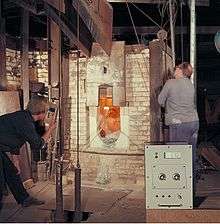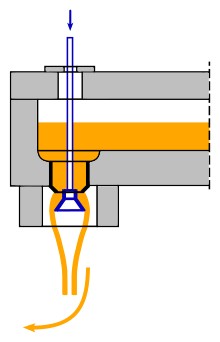Glass tube
Glass tubed or glass tubing are hollow pieces of various glass types (like borosilicate, flint, aluminosilicate, soda lime, lead or quartz glass) with a large variety of applications which are laboratory glassware, lighting applications , solar thermal systems and pharmaceutical packaging to name the largest.[1] Glass tubing is frequently attached to rubber stoppers.
In the past, scientists constructed their own laboratory apparatus prior to the ubiquity of interchangeable ground glass joints. Today, commercially available parts connected by ground glass joints are preferred; where specialized glassware are required, they are made to measure using commercially available glass tubes by specialist glassblowers. For example, a Schlenk line is made of two large glass tubes, connected by stopcocks and smaller glass tubes, which are further connected to plastic hoses.
History
Until the 19th century glass tubes were exclusively produced by mouth blowing, thus discontinuously manufactured from a batch or a glass melt. In 1912, E. Danner (Libbey Glass Company) developed the first continuous tube drawing process in the USA, which works in horizontal direction. In 1918 he received a patent. In 1929 a vertical drawing process was developed by L. Sanches-Vello in France.
Manufacturing Process
Glass tubes are produced in various types of glass and in diameters ranging from a few millimeters to several centimeters. In most production processes, an "infinitely long" glass tube is drawn directly from the melt, from which approximately 1.5 m long pieces are chopped off after passing a roller track up to the drawing machine.

The three common methods differ regarding the drawing direction:
Drawing direction horizontal
Danner process


In the Danner process, the molten glass runs from the feeder as a belt onto an obliquely downwardly inclined, rotating ceramic hollow cylinder, the Danner pipe. Through the hollow pipe, compressed air is blown to prevent the glass tube from collapsing. At the tip of the pipe the so-called drawing onion is formed, from which the glass tube is drawn off in the free sag on a horizontal pulling line.
If the drawing speed is kept constantly, an increase in the blow pressure causes larger diameters and smaller wall thicknesses;
With this method, tube diameters between 2 and 60 mm can be realized:
Vello process

In the Vello process, the glass runs through an annular slot from the bottom of the feeder. This slot is formed between the round outlet nozzle of the feeder and a height-adjustable hollow needle (also a mandrel). Here, the tube is "inflated" with compressed air as well. The glass tube which initially emerges in the vertical direction is then deflected into the horizontal position in the free sag.
The nozzle mandrel must be adjusted eccentrically to the drawing nozzle in order to avoid uneven wall thicknesses. Therefore, the resulting tube initially has different wall thicknesses, which balance out after the bending.
With this method, tube diameters between 1.5 and 70 mm can be generated; The throughput is higher than it would have been with the Danner method. Furthermore, it is possible here to use glasses with highly volatile components, such as borates (borosilicate glass) and lead oxides (lead glass), since the temperatures at the drawing nozzle are lower than in the Danner muffle.
Without a needle, glass rods can also be produced, whereby the diameter being adjusted via the nozzle as well as the drawing speed. Due to the vertical glass exit, draw-down processes are sporadically also listed under the general term “Vello”, although there is no forcible deflection into the horizontal.
Danner and Vello processes are used for the production of thin-walled glass tubes of relatively small diameter, with throughputs of up to 55 tonnes per day.
Drawing direction downwards (draw-down)
The draw-down method is, in principle, the same as the Vello method, although here the glass tube is not deflected but is pulled off in the vertical direction.
In the drawdown, tubes with maximum diameters of 350 mm and wall thicknesses of 2 bis 10 mm can be generated. For borosilicate glass (35 mm Durchmesser) a drawing speed of 0,3 m/min can be achieved.
Drawing direction vertically upwards (vertical drawing)
Here, the glass tube is not formed by a mandrel but is drawn off from the free bath surface. A nozzle protrudes from below into a drawing nozzle, via which the air is blown into the glass tube. The nozzle also holds the drawing onion so that it does not move out laterally. Since the quality and drawing speed achieved during the vertical tube drawing process are relatively low, this process has nowadays almost no practical significance.
Further procedures
Glass tubes with very large diameters (20 bis 100 cm), as required for plants of the chemical industry, are produced by centrifugation or blowing. However, only the production of relatively short tube sections of up to one meter, so-called tube shots, is possible.
Modifying
Although modifying glass tubing is no longer an essential laboratory technique, many are still familiar with the basic methods. A glass cutter is used to break pieces of glass tubing into smaller pieces. Freshly cut edges are flame polished before use to remove the rough edge. Glass tubing can be bent by heating evenly over a Bunsen flame to red heat. Hose barbs can be added to tubing, giving a better grip and seal for attaching plastic or rubber tubing.[2]
Applications
Glass tubes, rods and profiles can be made from different glass types. They find use in a variety of markets such as pharmaceuticals, industrial and environmental technology as well as electronics. Glass tubes are processed in:
- measuring cylinders
- halogen lamps
- pharmaceuticals packaging
- fluorescent lamps
- photobioreactors
- Interior Design
- Lighting concepts
- product presentation
- backlights
- photo-flash lamps
- pneumatic conveyor systems
Manufacturers
There are several companies concentrating on the production of glass tubes made from special glass types. By using a special glass type with particular properties the glass tubes can be fit for a variety of applications. Some well-known manufacturers of glass tubes are:
- Four Stars Glass Tube Co., Ltd.
- Nipro Glass
- Gerresheimer AG
- SCHOTT AG
References
- ↑ Boltres, B. : When Glass meets Pharma, 1. Auflage, ECV Editio Cantor, 2015, ISBN 978-3871934322
- ↑ Turpin, G. S. Practical Inorganic Chemistry. Forgotten Books. pp. 29–32.